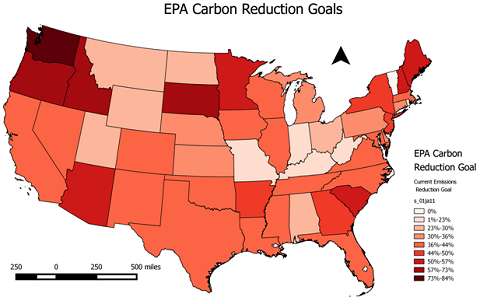EPA Proposes Power Sector CO2 Emissions Reduction Plan
 With cap-and-trade and carbon tax proposals going nowhere in congress, the Obama administration is tackling the global warming issue through the administrative branch, using U.S. Environmental Protection Agency regulations. In the transport sector, the administration promulgated vehicle fuel efficiency (mileage) standards. In the power sector, the EPA has proposed regulations requiring that all new power plants emit no more CO2 than a typical natural gas plant-thus, any new coal plants would have to employ CO2 sequestration. And now, the EPA is proposing to address CO2 emissions from existing power plants by establishing CO2 emissions reduction requirements for the power sector.
With cap-and-trade and carbon tax proposals going nowhere in congress, the Obama administration is tackling the global warming issue through the administrative branch, using U.S. Environmental Protection Agency regulations. In the transport sector, the administration promulgated vehicle fuel efficiency (mileage) standards. In the power sector, the EPA has proposed regulations requiring that all new power plants emit no more CO2 than a typical natural gas plant-thus, any new coal plants would have to employ CO2 sequestration. And now, the EPA is proposing to address CO2 emissions from existing power plants by establishing CO2 emissions reduction requirements for the power sector.
EPA proposed rules
Under the proposed rules, each state would be required to reduce its power sector CO2 emissions rate (in tons of CO2 per MW-hr) by a certain percentage by 2030. Some interim goals will also apply. Details of the plan are described on the EPA's website.
When establishing the emissions reduction goals for each state, the EPA considered five likely, low-cost means that the states may employ to reduce emissions. These include:
- Increased thermal efficiency for fossil plants (6 percent average increase assumed for the coal fleet).
- Increased use of existing gas-fired plants, in place of coal (usage increased to 70 percent).
- 5.8 GW of new nuclear and continued operation of "at risk" nuclear units.
- Increased renewable generation (to 13 percent of overall generation by 2030).
- Electricity conservation (10.7 percent reduction in demand by 2030).
The EPA is not requiring the exact measures described above to be taken by the states. The above assumptions are simply the basis that the EPA used to arrive at "reasonable" emissions rate reduction requirements for various states. They are steps that states are already taking or are planning on taking, or steps that the EPA believes can be taken at very low cost.
The only requirement is the emissions rate (tons CO2/MW-hr) reduction percentage that applies to each state. Each state is free to choose the means by which it will meet the requirement. States are also free to engage in inter-state emissions trading to meet the goals (thus allowing some states to emit more than the goal if other states manage to emit less). Such trading schemes may result in some effective price being put on CO2 emissions.
The emissions reduction requirements for each state are based on the assumption that the five new nuclear reactors under construction in the United States go into operation. They also assume that the ~5.8 percent of U.S. nuclear capacity deemed to be "at risk" continues to operate (i.e., that any necessary steps or incentives to keep them open are taken). Thus, the proposed regulations do provide a tangible incentive to finish the five plants under construction and keep all existing nuclear plant operating. If any nuclear plants close, or if any of the five construction projects are halted, the states in question would be significantly affected, as they would need to find other, significant sources of reductions that were not otherwise planned.
The requirements are also based on an assumption that, on average, natural gas plants in the state that are in operation or currently under construction will operate with a 70 percent capacity factor (vs. ~55 percent now). Thus, they assume that coal generation will be displaced by increased gas generation from any under-utilized gas-fired plants in the state. They do not assume any new gas plant construction (to replace coal), however.
The requirements are also based on the assumption that renewables will increase to 13 percent of generation, mostly based on existing state renewable generation (portfolio) requirements and other state plans. States are also assumed to reduce power demand by 10.7 percent (vs. current projections, using new demand-side management programs). These demand reductions are essentially treated like non-emitting generation, and are part of the quoted percentage emissions reduction for each state.
State requirements
The state requirements are illustrated in the figure below. State by state requirements are also shown in tabular form here. The state requirements are expressed in terms of percentage reductions in tons of CO2 emitted per MW-hr of generation, from 2012 to 2030.
At first look, many of the state requirements seem odd, with states that already have low emissions (like Washington) having significant reduction requirements, while "coal states" like Kentucky and West Virginia have very small reduction requirements. One would think that such coal states would be the most ripe for reductions, mainly by replacing coal plants (especially old inefficient ones) with gas generation. The reason for this is that the EPA requirements are largely based on existing state plans.
For example, Washington is planning on closing the one large coal plant in the state, which is the source of most of the state's power sector CO2 emissions. The EPA based its reduction requirement on those plans, and is essentially requiring the state to go forward with them.
The reason for the low reduction requirements for Kentucky and West Virginia is that few if any natural gas plants exist in those states. As stated earlier, the EPA did not consider the construction of new gas-fired plants in any states when making its estimates for "feasible" reductions. It only considered increased utilization of existing gas plants within the state.
Another example that stands out is the large (51.4 percent) reduction required for South Carolina. The primary reason for the strict requirement is the two-unit V.C. Summer nuclear project in the state. Those two reactors will result in a significant reduction in state CO2 emissions, and the EPA is essentially requiring that those projects go forward.
Overall national reduction goal
The EPA states that the proposed rules will result in national power sector emissions in 2030 that are 26 percent to 30 percent below 2005 levels. It should be noted that power sector emissions have already fallen ~15 percent between 2005 and 2013. Thus, the policies would actually only decrease emissions by another ~10-15 percent from today.
Even after reading most of the press releases and other documents on the EPA website and elsewhere, I have been unable to determine with certainty if the national reduction quoted above is a 26-30 percent reduction in actual, absolute emissions (in tons per year), or a reduction in emissions per MW-hr generated. The EPA refers to a 26-30 percent reduction in "CO2 emissions" (suggesting an absolute emissions reduction), but all state requirements are given in units of emissions (tons) per MW-hr. Looking over all the tabulated state reduction requirements suggests an average (i.e., national) reduction requirement of ~30 percent, in tons/MW-hr. Could the EPA really be referring to a reduction in per MW-hr emissions when it speaks of "CO2 emissions reductions" (i.e., is it using misleading/evasive language)?
This question is significant, since the U.S. Energy Information Administration projects an increase of ~26 percent in overall U.S. electricity generation between 2012 and 2030. Thus, a ~30 percent reduction in tons/MW-hr would result in ~26 percent more emissions than a ~30 percent reduction in absolute emissions (tons/year). The EPA assumed that states would reduce overall electricity use by 10.7 percent, versus current projections (of a 26 percent increase, presumably). However, those reductions are essentially treated like zero-emissions generation, and are included in the state emissions/MW-hr reduction goals. That is, the required percentage reduction in CO2/MW-hr for the state's power generation is actually less than that quoted, unless the state fails to reduce demand.
Part of the answer lies in the use of 2005 vs. 2012 as a base year. As discussed above, a 30 percent emissions reduction (in tons/year) from 2005 equates to a reduction of only 10-15 percent from 2012 levels. If one assumes that power generation increases by 26 percent, but the tons of CO2 emitted per MW-hr decreases by 30 percent, the resulting overall emissions, in tons/year, would fall by ~12 percent (which lies within the range of 10-15 percent). Thus, I believe we have our answer. Overall emissions will decrease by 10-15 percent, from now to 2030. Emissions intensity (tons/MW-hr) will decrease by a larger amount (26-30 percent), but overall generation will increase somewhat.
It should be noted, however, that the requirements, as written, only limit emissions intensity and do not actually limit absolute emissions (in tons/year). Thus, if overall power generation increases by more than the expected amount, for whatever reason, absolute CO2 emissions will be allowed to increase accordingly. Any restriction or disincentive on CO2 emissions would not increase in response to increased generation.
Political considerations
The EPA's proposals appear to be designed to minimize political impacts, in my view. As discussed earlier, many if not most of the proposed "measures" are simply ratification of existing policies and plans, such as planned coal plant closures and state renewables mandates. Any new measures are ones that can be achieved at very low cost.
One of the only new aspects is a requirement to increase gas utilization, vs. coal, but even that measure is only applied to states with spare gas capacity, and not to coal states (which have little such spare gas capacity). The EPA's argument appears to be that constructing new gas plants (as opposed to simply using existing ones more often) would be too expensive. This argument appears weak, given the very low capital cost of gas capacity. It appears to me to be more of a political sop to the coal-dominated states, perhaps to avoid political resistance to the plan. The proposal is designed so that the impact on power generation in the states most politically opposed to the plan are virtually non-existent.
This appears to be a proposal that has a somewhat limited impact on emissions (relative to other/earlier proposals), but also is known to have very limited economic (and political) impacts. My view is that this is an attempt to get at least some sort of global warming policy established. This will set precedent, and establish the principle that this is something that warrants government action. Once the policy is established, policies that require further/continued reductions may be promulgated in the future, especially if (or when) it is seen that this policy had no significant negative impact on the economy. In any event, this is probably the strongest policy that can be attained right now, given attitudes in congress, and some policy is better than none.
Overall impacts
As discussed above, this proposal appears to be far weaker than other global warming proposals that have been put forward, such as the earlier cap-and-trade bill or various CO2 tax proposals.
The plan is estimated to yield a 30 percent reduction in emissions (vs. 2005) by 2030, from the power sector only (and only 10-15 percent from today). That corresponds to a reduction of just over 10 percent in overall emissions, vs. 2005 (and less than half of that vs. today). That compares to the (Waxman-Markey) cap-and-trade bill requirement of ~20 percent in overall CO2 emissions.
It must be noted that power sector emissions reduction options (e.g., replacing coal with anything else) are among the "lowest hanging fruit" with respect to cost effectiveness. A carbon price of $25-$30 per ton, enough to put many if not most existing coal plants out of business, would only add ~25-30 cents to a gallon of gasoline (i.e., not nearly enough to drive any significant changes in the transport sector). Thus, the old cap-and-trade bill was actually far more significant in terms of impacts and reductions demanded. To get a ~20 percent reduction in overall emissions, the reductions from the power sector would have been far greater than 20 percent (its reduction measures being cheaper than other sectors).
It should be noted that coal is still projected to represent ~30 percent of overall generation in 2030, even under these proposals. Coal formerly was over 50 percent, and recently fell to ~34 percent (in 2012). Now, because natural gas prices have gone back up somewhat, coal is back up to ~40 percent. (Note that, whereas when a nuclear plant closes it's closed forever, utilities turn mothballed coal plants right back on when they become slightly cheaper to operate than gas, with no consideration of the drastic difference in health and environmental impacts.) Thus, all the proposals are doing is bringing coal back down to where it was a couple years ago with no policy input.
My opinion is that, given that shutting down old coal plants and replacing them with gas (if nothing else) represents one of the least expensive means of emissions reduction, any plan that leaves coal's generation percentage at 30 percent in 2030 simply isn't trying hard enough.
Indeed, I believe most of the EPA's proposed reduction measures discussed earlier are estimated to have costs of only ~$15 per ton of CO2. Most carbon tax proposals involve significantly higher CO2 prices.
Most earlier proposals also required more significant reductions in overall (all sector) emissions by 2030. Those requirements, along with other assumptions such as higher natural gas prices, led to significantly different predicted outcomes, including much lower coal use and much higher nuclear use. I seem to recall one EPA study of a cap-and-trade policy that predicted a nuclear generation share of ~60 percent.
Impacts on nuclear
As stated earlier, the EPA's policies should be a significant help in assuring that existing nuclear construction projects go forward, and in preventing any more nuclear plant closures, as these are the assumptions "baked into" the emissions requirements for each state. Whether or not the policy will stimulate any additional nuclear construction is far less clear.
The emissions goals for each state were based on current plans and additional measures estimated to cost ~$15/ton of CO2. A CO2 price of ~$15/ton is certainly not enough to stimulate much in the way of new nuclear plant construction, although it is probably enough to keep existing plants open. While larger emissions reductions would require higher costs (CO2 prices), the EPA's analysis and proposals do seem to show that significant reductions can be achieved at very modest costs (and through mere continuation of existing plans and policies); something that is somewhat disconcerting with respect to new nuclear plant prospects.
Perhaps the main impact of the proposed policy, both on nuclear and in general, is that it cements current plans and policies, and prevents any back-tracking. The most significant example of this concerns the use of gas vs. coal. Without the policy, utilities will go right back to coal if the cost of natural gas rises. The EPA policies will essentially disallow switching back from gas to coal, and will instead require some further replacement of coal with gas. We've already back-tracked from 34 percent coal use back to ~40 percent. The EPA policies will drive coal use back down to ~30 percent. And they will do so even if natural gas prices rise in the future; a very important point.
That last point is probably the most significant in terms of whether the EPA's proposed policy will ever result in new nuclear construction projects. If the price of natural gas increases significantly in the future, nuclear may become competitive. The EPA policies would prevent shifting back to coal as an alternative to new nuclear (or renewable) capacity. Preventing a shift back to coal would also tend to keep gas prices up, as a shift back to coal would no longer act as a means of limiting gas demand. On the other hand, if the price of natural gas remains low, the proposed EPA policies would do little, if anything, to stimulate new nuclear construction, in lieu of just using more gas.
Call to action
Another option for increasing the odds of new nuclear plant construction would be to argue for policies that treat all non-CO2-emitting sources the same. As the EPA is leaving it up to each state to determine how to comply with the proposed rules, such policies would most likely be set at the state level. The state emissions goals are based on the continuation of existing renewable generation requirements and plans, and renewables accounting for 13 percent of overall national generation in 2030. The states are free to use nuclear, in lieu of renewables, for some of that generation under the EPA policy.
This is an area where the American Nuclear Society, nuclear engineers, and nuclear advocates need to get involved. The EPA's proposed rules are now out for public comment. Also, states are beginning to develop plans for how they will respond to the emissions reduction requirements. Nuclear experts and advocates need to make the case for a technology-neutral approach. Certainly, we should advocate neutrality for any new state policies. Cap-and-trade systems in lieu of portfolio standards are also something we could argue for. Revision of existing state renewable portfolio standards to include nuclear (in order to reduce compliance costs) would be a bit more difficult to achieve, but is still worth pursuing.
_________________

Hopf
Jim Hopf is a senior nuclear engineer with more than 20 years of experience in shielding and criticality analysis and design for spent fuel dry storage and transportation systems. He has been involved in nuclear advocacy for 10+ years, and is a member of the ANS Public Information Committee. He is a regular contributor to the ANS Nuclear Cafe.


